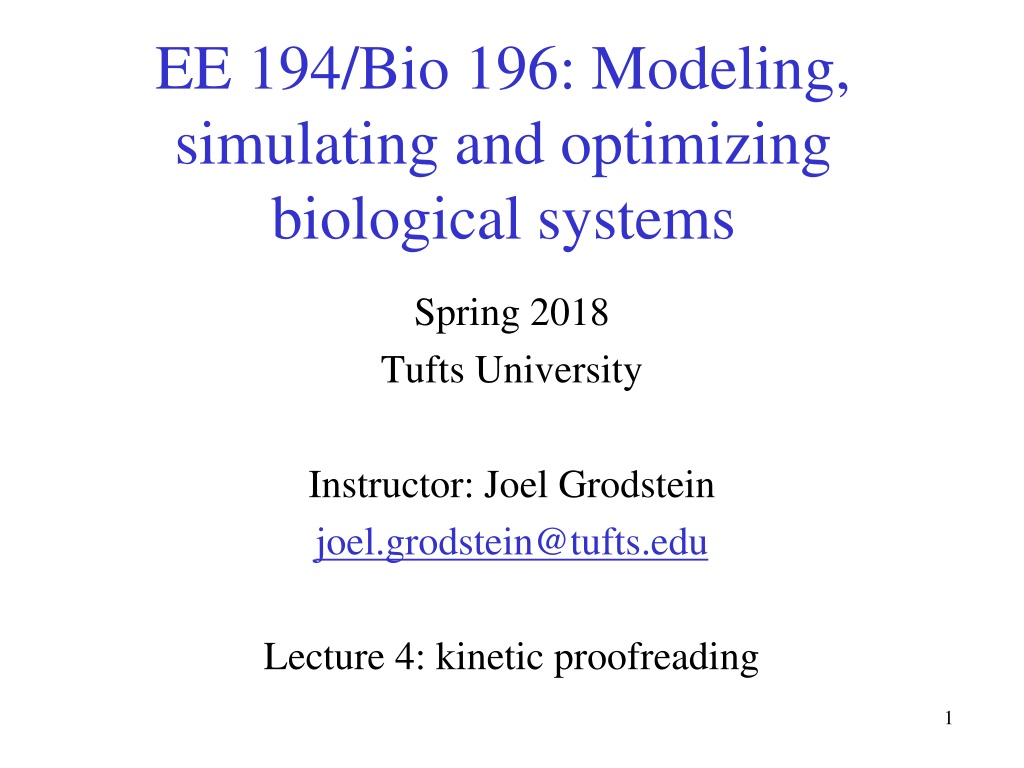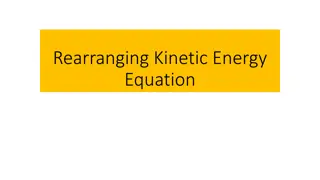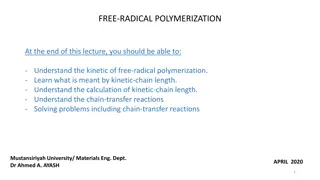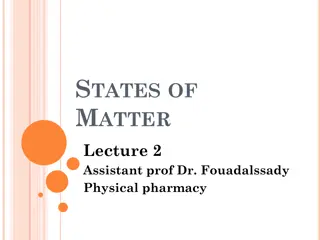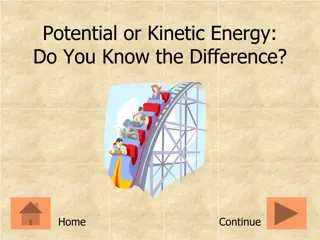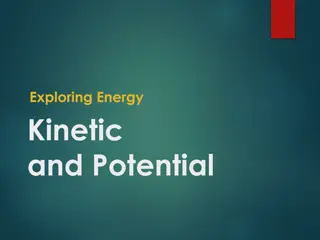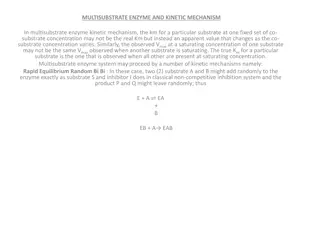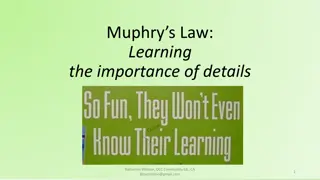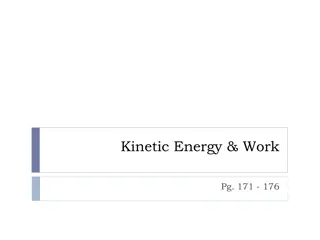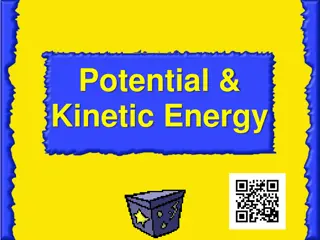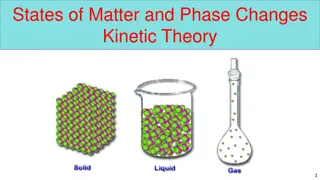Understanding Kinetic Proofreading in Biological Systems
Kinetic proofreading is a crucial mechanism by which the body accurately discriminates between closely-related molecules, such as mRNA codons and tRNA molecules in the process of protein synthesis. This process ensures that the correct molecules bind together, preventing errors that could have severe consequences. Through this process, the body showcases a remarkable ability to recognize specific molecules, surpassing basic chemistry predictions. Kinetic proofreading plays a significant role in the translation process, highlighting the complexity and precision involved in biological systems.
Download Presentation

Please find below an Image/Link to download the presentation.
The content on the website is provided AS IS for your information and personal use only. It may not be sold, licensed, or shared on other websites without obtaining consent from the author. Download presentation by click this link. If you encounter any issues during the download, it is possible that the publisher has removed the file from their server.
E N D
Presentation Transcript
EE 194/Bio 196: Modeling, simulating and optimizing biological systems Spring 2018 Tufts University Instructor: Joel Grodstein joel.grodstein@tufts.edu Lecture 4: kinetic proofreading 1
Kinetic proofreading What we ll learn about biology How the body discriminates between closely-related molecules What we ll learn about modeling Inverse problems: find the parameters that give us a desired output Exhaustive algorithms try practically everything and still finish before dinner Emergent properties A simple framework for modeling molecular biology What we ll learn about programming if/then, multiply-nested loops, 1 HW EE 194/Bio 196 Joel Grodstein 2
Background reading Interesting reading (not required for class) An Introduction to Systems Biology: Design Principles of Biological Circuits, Uri Alon, Chapter 9 (on reserve) Kinetic proofreading: a new mechanism for reducing errors in biosynthetic processes requiring high specificity, J.J. Hopfield, PNAS 1974 Direct experimental evidence for kinetic proofreading in amino acylation of tRNAIle, ibid, PNAS 1976 EE 194/Bio 196 Joel Grodstein 3
Kinetic proofreading What is it, and why do we care? Kinetic proofreading is when your body is much better at recognizing specific molecules than it seems it should be Example: mRNA codons bind to one specific tRNA molecule Bind to the wrong one build a protein from incorrect amino acids Example: antibodies are amazingly good at recognizing, binding and targeting one specific antigen Even if other antigens look very similar Consequences of attacking the wrong molecule are severe Does it sound easy? Your body does much better than basic chemistry would seem to predict EE 194/Bio 196 Joel Grodstein 4
mRNA and tRNA Central dogma of biology DNA is transcribed to create an mRNA chain each codon of mRNA mates with a specific tRNA molecule tRNA has an anti-codon on one end (that mates w/mRNA); the other end of tRNA is the appropriate amino acid EE 194/Bio 196 Joel Grodstein 5
Why isnt translation easy? Translation seems like it should be easy bf p mRNA+tRNA mRNA tRNA product br amino acid added to the protein mRNA binds to tRNA For those who recognize it Sort of the same idea as Michaelis-Menton kinetics 6 EE 194/Bio 196 Joel Grodstein
Simple analysis bf p mRNA+tRNA mRNA tRNA product br Equilibrium definition: All reactions have their forwards and rate balance the reverse rate Thus, all [metabolites] are unchanging Thermodynamics says that any isolated system will eventually reach equilibrium (maximal entropy) Why isn t the product reaction at equilibrium? Irreversible reactions cannot be at equilibrium. A contradiction? No reaction is completely irreversible As long as we re alive, our body can sweep away products and make reactions essentially irreversible EE 194/Bio 196 Joel Grodstein 7
Molecular machines Ribosome is a molecular machine In practice, molecular machines are often irreversible Machines usually expend energy E.g., convert ATP ADP Running backwards is highly unlikely (2nd Law again) Your body fuels the machines by eating EE 194/Bio 196 Joel Grodstein 8
Analyzing a simple model bf mRNA+tRNA mRNA tRNA br Equilibrium equations Forwards reaction rate: ?????? ???? Reverse reaction rate: ?????? ???? At equilibrium, ?????? ???? = ?????? ???? , or ???? ???? = ?????? ???? . This is called mass-action equilibrium No matter where you start, the system will eventually move to equilibrium ?? EE 194/Bio 196 Joel Grodstein 9
Simple model is not robust GUA=valine, AUA=isoleucine. These codons are pretty similar. mRNAGUA binds very well to tRNAGUA but also pretty well to tRNAAUA! mRNAGUA + tRNAGUA mRNAGUA tRNAGUA (bf, br,good) mRNAGUA + tRNAAUA mRNAGUA tRNAAUA (bf, br,bad) Some numbers: bfis about the same for both cases (that s why I didn t call them bf,good and bf,bad) br,bad 100 br,good From earlier: ???? ???? = ?????? ???? So according to mass-action equilibrium, we should get about 100x less [mRNAGUA tRNAAUA] than [mRNAGUA tRNAGUA] Average number of amino acids in a human protein 500 If 99% of our amino acids were correct 5 mistakes per protein! In fact, 99.99% are correct. An occasional bad protein will eventually degrade Conclusion: the body has some non-obvious mechanism to make the central dogma work 100x more reliably than expected ?? EE 194/Bio 196 Joel Grodstein 10
Bodily time scales A few time scales in your body: TF binding to a promoter: seconds DNA mRNA: minutes mRNA protein: minutes mRNA lifetime: 10s of minutes (creating 10s of proteins) protein lifetime: 10s of hours So a 1% error rate is bad, but .01% is OK EE 194/Bio 196 Joel Grodstein 11
The mystery, circa 1970 The body works really well but how? The facts as of 1973 ef bf p mRNA+tRNA mRNA tRNA mRNA tRNA* product br er dr df amino acid added to the protein but what are these reactions for? mRNA+tRNA mRNA binds to tRNA We knew the reactions We did not know all of the rate constants Problem in molecular biology: until you know the rate constants, it s not always obvious what reactions are for We did not know what the extra reactions were for People did not really know how to proceed 12 EE 194/Bio 196 Joel Grodstein
Are the issues linked? Our two mysteries: Two reactions that don t seem to have a purpose (if we knew the rate constants, maybe we would know their purpose) The system is 100x more reliable than we would predict Are these related? And what are the missing rate constants? Our hope: for some magic set of rate constants, kinetic proofreading will magically appear EE 194/Bio 196 Joel Grodstein 13
Proofreading 1974 JJ Hopfield hypothesis: hypothesizes the missing rate constants in fact, they explain how the useless reactions make the system reliable 1976: two years of lab work prove him correct I have all of these reactions and I don t know what they do: a hard problem I have a specific hypothesis: prove or disprove it: often a much easier problem. Allowed the lab work to be very focused EE 194/Bio 196 Joel Grodstein 14
What did he do exactly? Build a model: mass action rates on 4 chemical reactions A set of differential equations State: concentrations of mRNA, tRNA, bound complex, bound-excited complex, product Parameters: the rate constants EE 194/Bio 196 Joel Grodstein 15
Coupled differential equations Coupled differential equations for one reaction ? ???? ???? ?? ? ???? ?? ? ???? ?? The general form: ??1 ??= ? ?1,?2, ,?,?????? ??2 ??= ? ?1,?2, ,?,?????? ??3 ??= ? ?1,?2, ,?,?????? = ?????? ???? ?????? ???? = ?????? ???? ?????? ???? the things we care about = ?????? ???? ?????? ???? how fast they re changing parameters EE 194/Bio 196 Joel Grodstein 16
What did he do exactly? Invent rate constants they must reasonable they must make the model match the data (i.e., robustness) inventing rate constants is hard so many choices for the rate constants How to tell if we match the data Simulate the model once with the rate constants for mRNAGUA reacting with tRNAGUA; record the predicted [productgood] Simulate again with the rate constants for mRNAGUA reacting with tRNAAUA; record the predicted [productbad] Check that [productgood] 10000[productbad] Spoiler alert for HW #4: there will indeed be a magic set of rate constants that allows life to exist on earth, and you will find it EE 194/Bio 196 Joel Grodstein 17
Bottom-up, emergent model This is an example of bottom-up, emergent modeling Bottom-up: Put together the low-level reactions, with as many details as possible Assemble them into a system Emergent: With the right combination of parameters, a surprising and difficult-to- predict behavior suddenly emerges from the pieces Bottom-up, emergent modeling is quite common in biology; we ll see other alternatives shortly Pros: your final model has lots of detail, and probably is not GIGO it matches the real reactions, and might thus be easier to validate in the lab Cons: Lots of low-level pieces often make it hard to understand Intuition may be lacking EE 194/Bio 196 Joel Grodstein 18
What well do How did Hopfield come up with his rate constants? Stroke of genius, message from God, who knows Either way, miraculous guesses are hard to come by Instead, we ll use optimization What is optimization? Optimization, in general: find a way to make something as good as possible Pick the rate constants so that we maximize the production of correct amino acids vs. incorrect ones EE 194/Bio 196 Joel Grodstein 19
Optimizing a model bf ef p mRNA+tRNA mRNA tRNA mRNA tRNA* product br er dr df mRNA+tRNA How many rate constants are there? bf, br, ef, er, df, dr, p How many values could each of them have? Pretty much anything! Our task: Try an infinite number of values for each of 7 parameters Simulate each choice and see if any give us reliability Finding a needle in a haystack sounds easier Our goal: write a computer program that can try an infinite number of choices, and find the needle. Do it in half an hour. Sound useful? 20 EE 194/Bio 196 Joel Grodstein
Why do we care (take 2) Because kinetic proofreading is cool Because kinetic proofreading is a general concept: used in translation, in the immune system, in DNA replication/damage/repair, Because it gives us a reason to learn about optimization EE 194/Bio 196 Joel Grodstein 21
Our task, again Our task: Try an infinite number of values for each of 7 parameters Simulate each choice and see if any give us reliability Simulate each choice and see if any give us reliability Set the parameters to the desired values Set brto the good (i.e., low) value; simulate the model to find how fast we make the good AA Set br100x higher; simulate again to find how fast we make the bad AA Hopefully, there s a 10000x difference in AA production Try the next parameter choice EE 194/Bio 196 Joel Grodstein 22
How many choices to try Our task: Try an infinite number of values for each of 7 parameters Simulate each choice and see if any give us reliability Try an infinite number of values for each of 7 parameters This sounds kind of impossible. Ideas? Do we really have to try every parameter value? No model is perfect: some are still useful How good does our model have to be? Good enough to screen away the bad rate-constant choices and focus lab work on the good one Modeling + optimization find a small number of reasonable hypotheses EE 194/Bio 196 Joel Grodstein 23
Equilibrium ef bf p mRNA+tRNA mRNA tRNA mRNA tRNA* product br er dr df mRNA+tRNA Take a closer look at these equations ?? ?????? ???? At equilibrium, we must have ???? ???? = Don t we have the same issue all over again? Limited by df and dr for the good and bad bindings? Not limited because our body is not at equilibrium We re constantly expending energy as long as we re alive Equilibrium = death 24 EE 194/Bio 196 Joel Grodstein
What does good enough mean? Close is only good enough in horseshoes and hand grenades Rate constants often do not need to be exact We ll take advantage of this on the HW, and then talk about why it works Idea: trying an infinite number of parameter choices takes, well, an infinite amount of time Try just enough to get within 10x? E.g., all rates can be 1, .1, .01, .001, .0001 and 0. 6 choices for 7 parameters: very feasible to try them all. A lot fewer than infinity Our optimization strategy: decide on a reasonable range of choices for each rate, and try every combination and biochemistry! EE 194/Bio 196 Joel Grodstein 25
Our optimization strategy Our strategy: decide on a reasonable range of choices for each rate try every combination Only really works if: almost is good enough you have a computer fast enough to try quite a few choices to see what is best EE 194/Bio 196 Joel Grodstein 26
In-class programming exercise Reminder on for p1 in [1, .1, .01] (arrays lecture foil 16) Write code to: try the values [1, .1, .01, .001, .0001 and 0] for each of 3 parameters p1, p2 and p3. for each parameter choice, call a function sim (p1, p2 and p3). This function returns a goodness value. Save the best parameter choice EE 194/Bio 196 Joel Grodstein 27
Understanding the results ef bf p mRNA+tRNA mRNA tRNA mRNA tRNA* product br er dr df mRNA+tRNA What will our results tell us? bf and br are much faster than ef and er. er=df=0 (i.e., two irreversible reactions) Let s try to understand how/if this helps EE 194/Bio 196 Joel Grodstein 28
The intuition ef mRNA tRNA* product bf p mRNA+tRNA mRNA tRNA br er dr df mRNA+tRNA Assume that bf and br are much faster than ef and er. Then the leftmost reaction quickly reaches equilibrium, independent of everything else with ???? ???? = ?????? ???? ?? 29 EE 194/Bio 196 Joel Grodstein
Part 1: 100x discrimination 1 mRNA+tRNA mRNA tRNA .5 1 1 Correct tRNA 2 1 mRNA+tRNA mRNA tRNA 50 1 1 Wrong tRNA .02 We get 100x discrimination just in the binding/unbinding 30 EE 194/Bio 196 Joel Grodstein
concentration stays constant at ?????? ???? ?? ef p bf mRNA+tRNA mRNA tRNA mRNA tRNA* product br mRNA tRNA mRNA tRNA* product er dr df mRNA+tRNA ?? ?????? ???? OK, so ???? ???? = Assume p is the slowest (so we can ignore it for now) Assume er=df=0 (i.e., two irreversible reactions) 31 EE 194/Bio 196 Joel Grodstein
concentration stays constant at ?????? ???? ?? ef v mRNA tRNA mRNA tRNA* product dr mRNA+tRNA At steady state, [mRNA tRNA*] must be unchanging. its production rate is ef[mRNA tRNA] its consumption rate is dr[mRNA tRNA*] So ef[mRNA tRNA]= dr[mRNA tRNA*], or ???? ???? = ?? ?????? ???? Electrical engineers: looks like a voltage divider 32 EE 194/Bio 196 Joel Grodstein
.01 mRNA tRNA mRNA tRNA* 2 .04 .5 Correct tRNA mRNA+tRNA 1 1 .01 mRNA tRNA mRNA tRNA* 2 100x discrimination .0004 50 mRNA+tRNA 1 1 .01 mRNA tRNA mRNA tRNA* .02 .000004 Wrong tRNA 10000x discrimination 50 mRNA+tRNA 1 1 33 EE 194/Bio 196 Joel Grodstein
Summary ef bf p mRNA+tRNA mRNA tRNA mRNA tRNA* product br er dr df mRNA+tRNA happens quite fast; essentially always at equilibrium [mRNA tRNA] is 100x more for the correct binding To the rest of the system, it seems like it presents a constant concentration Very similar system; adds another 100x discrimination. Concentrations here are independent of the first reaction (at least for a while) [mRNA tRNA*] is 10000x more for the correct binding EE 194/Bio 196 Joel Grodstein 34
What was the cost? ef bf p mRNA+tRNA mRNA tRNA mRNA tRNA* product br er dr df mRNA+tRNA The reactions are only independent because: Separation of time scales made it work. But that means the system isn t done until the slowest time scale. So we paid in speed Excitation and decay are irreversible. That s because there s a molecular machine that expended energy. So we paid in food cost EE 194/Bio 196 Joel Grodstein 35
What if 1 1 mRNA+tRNA mRNA tRNA mRNA tRNA* .5 1 1 Correct tRNA .66 1 1 Wrong tRNA mRNA+tRNA mRNA tRNA mRNA tRNA* 50 1 1 .02 Excitation happened as fast as binding? Intuition: so much [mRNA tRNA] exits to the right that the difference between (1+.5) vs. (1+50) is no longer 100x Discrimination is less powerful EE 194/Bio 196 Joel Grodstein 36
What if .01 1 mRNA tRNA mRNA tRNA* product .5 Correct tRNA 2 .013 mRNA+tRNA 1 1 .01 1 mRNA tRNA mRNA tRNA* product 50 Wrong tRNA .0004 2 mRNA+tRNA 1 1 Product formation were very fast? Intuitive argument: mRNA tRNA* would get turned into product so quickly that the difference between (1+.5) vs. (1+50) is no longer 100x Again, discrimination is less powerful EE 194/Bio 196 Joel Grodstein 37
What if .01 mRNA tRNA mRNA tRNA* 2 Correct tRNA 2.04 .5 1 mRNA+tRNA 1 1 .01 mRNA tRNA mRNA tRNA* .02 Wrong tRNA .02 50 1 mRNA+tRNA 1 1 Decay is not irreversible? Only 100x discrimination, not 10000x Intuitive argument: mRNA tRNA* would be created so quickly by new bindings that our first discrimination step would be irrelevant EE 194/Bio 196 Joel Grodstein 38
Horseshoes and hand grenades Why was it OK to only get the rate constants good enough? Rate constants often do not need to be exact They say which reactions have roughly the same rate (and so reach steady state jointly) which reactions are way faster (can treat them as at equilibrium) which are slower (they just sample the results of the others) which are really slow (essentially irreversible) Life must persist given unpredictable conditions Cellular growth rates vary widely depending on environmental conditions Mutations occur Enzymes float around unpredictably We ve evolved to be extraordinarily robust Life must tolerate changes in reaction rates EE 194/Bio 196 Joel Grodstein 39
Talk about the lab code EE 194/Bio 196 Joel Grodstein 40
How do molecular machines work? Building a tiny machine is hard cytoplasm is very viscous to a molecule. Like swimming in honey life in the world of low Reynolds numbers How do you get energy from one place to another? flywheels don t work inertia doesn t work store energy in chemical bonds ratchet/pawl works pretty well 2016 Nobel prize for chemistry: molecular machines EE 194/Bio 196 Joel Grodstein 41
The ribosome as a molecular machine The ribosome is a complex machine https://www.youtube.com/watch?v=1PSwhTGFMxs EE 194/Bio 196 Joel Grodstein 42
The immune system Anything that the immune system attacks is an antigen Some antigens (e.g., pollen) are not pathogens White blood cells called T cells recognize antigens Each T cell binds with a slightly different antigen The entire set of T cells can bind a very wide range of antigens B cells are involved also (not relevant here) T cell + antigen activated complex Starts a chain reaction that inactivates the antigen or kills the host cell. Initiates clonal selection: T cell reproduces, producing effector T cells (which fight infection as above) and memory cells. This reproduction involves mutation; those that best bind the antigen undergo further clonal selection. Effector cells die off after this infection; memory cells remain in your body for future infections EE 194/Bio 196 Joel Grodstein 43
Result: an evolution-like process quickly produces T cells that bind/kill the antigen quite precisely But: what if an antigen mistakenly binds something else? E.g., binding pollen (hay fever) Various auto-immune diseases Antigens often have a shape that does not differ greatly from other molecules in the body Why aren t auto-immune diseases more common? Nobody quite knows but a form of kinetic proofreading is believed to be important EE 194/Bio 196 Joel Grodstein 44
Compound interest Stocks earn, on average, 7% Start with $1. Invest it at 7% interest for 200 years $750K A mutual fund may take 1% in fees. Start with $1, 6% for 200 years, you have $115K How did that happen? Compounding over enough time makes small differences really big Exponential growth is a very powerful thing EE 194/Bio 196 Joel Grodstein 45
bf T cell+antigen bound complex bra bf T cell+non-antigen bound complexnon-antigen brn Energetics: A T cell can bind to either an antigen or another molecule easily (both are energetically favorable) A T cell will unbind from a non-antigen quite quickly, but will stay bound to an antigen longer Assume brn 10bra ????? ???????? = ?? ???? ???? ??????? Conclusion: at equilibrium 10x as much [bound complexa] as [bound complexna]. That s not good enough ?? ???? ???? ??????? ????? ????????? = EE 194/Bio 196 Joel Grodstein 46
bf T cell+antigen bound complex bra bf T cell+non-antigen bound complexnon-antigen brn A different point of view (still assume brn 10bra) If an antigen has .9 likelihood of staying bound after 1 second, then is has ? likelihood of staying bound after n seconds Then the non-antigen would have .09nlikelihood of staying bound after n seconds If n=7, then the antigen is 10M x more likely to stay bound That doesn t change the fact that 10x as much [bound complexa] as [bound complexna] at equilibrium. Things bind and unbind all the time, and usuallythere s no prize for who stays bound the longest .9n 47 EE 194/Bio 196 Joel Grodstein
Phosphorylation T cell +antigen bound complex Bound complex gets phosphorylated (another molecular machine) And then again. And again Only after it gets phosphorylated numerous times does it attack an antigen. Any time the antigen unbinds, all of the phosphorylation is removed The next antigen to bind will start from a clean slate Phosphorylation acts as a timer, ensuring that a molecule must stay bound a long time before being attacked Kinetic proofreading A molecular machine magnifies small affinity differences No free lunch: the machine requires energy and time EE 194/Bio 196 Joel Grodstein 48
T-cell references T cell activation, Jennifer Smith-Garvin, Annual Rev. Immunology 2009 Excellent overall reference Phenotypic models of T cell activation, Nature Reviews Immunology 2014 Current review of the different hypotheses for activation (including multiple variants of proofreading) Alon chapter High-level, readable overview EE 194/Bio 196 Joel Grodstein 49
More detailed model Excitation Product Binding Decay The model we ve presented in class is over-simplified The overall form is very similar Two discrimination stages, separated by irreversible reaction The differences are in the details *Picture from Recognition and selection of tRNA in translation, Rodnina 2004 50 EE 194/Bio 196 Joel Grodstein
